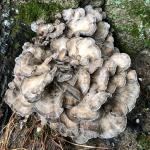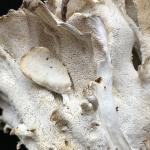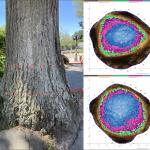Root and Butt Rot caused by Grifola frondosa (Hen of the Woods)
Pathogen
The native fungal pathogen Grifola frondosa is commonly referred to as Hen of the Woods or Maitake.
Hosts
Oaks (Quercus spp.) are the primary host while other deciduous hardwoods are occasionally attacked (Luley 2022).
Symptoms & Signs
Grifola causes a white pocket rot of the roots and lower trunk that advances slowly within infected oaks. Lignin is preferentially targeted while cellulose remains mostly intact (Schwarze et al. 2000). As a result, the localized pattern of decay reduces structural stability only gradually over time. Oaks with fruiting bodies growing at the base are not necessarily a high risk for uprooting or stem failure under loading from strong winds. The late stages of decay appear as a white pocket rot in the heartwood surrounded by less decayed wood that is darker in color, usually orange to reddish-brown (Schwarze et al. 2000). The annual mushrooms are similar in appearance to those produced by Meripilus sumstinei (Black-Staining Polypore). They develop in a rosette pattern of overlapping caps attached to a central stalk at the base. The caps are fan-like with the upper surface (pileus) appearing lavender-gray when young, becoming grayish-brown and sometimes dark brown with age. Older specimens exposed to freeze-thaw cycles late in the season can be very dark in color. The pore layer (hymenium) is usually off-white becoming tan to brown with age. The rosettes are typically found growing from the soil at the base of infected trees but at times can be growing from roots a few feet away. Fruiting bodies can appear anytime from late summer through the autumn season but in southern New England, they are often most abundant from mid-September to early October. Advanced decay is concentrated in the roots, but at times may advance upwards into the main trunk (Luley 2022). Like many wood-rotting fungal pathogens, Grifola also acts as a saprophyte on stumps and downed logs.
Management
Grifola is very common on oaks in managed landscapes and the presence of mushrooms during the autumn season often does not indicate serious decay is present. In addition, Grifola can co-occur with other wood-rotting fungi, such as Armillaria, Ganoderma and Laetiporus, so determining its role in the development of decay can be challenging. That said, trees harboring infections should be closely monitored and undergo a thorough risk assessment. As with any tree infected by a root and butt rot pathogen, maintaining high tree vigor is important. If annual increment growth can keep pace with the rate of decay in the heartwood, this may reduce the risk of failure. Maintain a large ring of mulch or wood chips around the tree and manage insect pests and pathogens that can weaken the tree. Improving soil quality may also increase vigor. Pruning to reduce canopy sway can also be performed. Regularly scout oaks for the presence of fruiting bodies and document their occurrence on and around the lower trunk. Mushrooms may appear annually for many years around the base of infected oaks. Minimally invasive decay detection techniques, such as resistance drilling and sonic tomography, are often required to understand the extent of the decay. Tomography scanning of infected trees in Massachusetts has revealed significant differences in decay severity when mushrooms are present. In some cases, oaks with several clusters of mushrooms at the base have no detectable decay in the lower trunk. In other cases, oaks are harboring significant butt rot and Grifola is the suspected causal agent based on the presence of the fruiting bodies. However, in these cases it’s unclear whether Grifola is simply more conspicuous than a more destructive and concealed pathogen (e.g. Armillaria).
References
Luley, CJ. 2022. Grifola frondosa. In: Wood Decay Fungi Common to the Northeast & Central United States, 2nd Edition. Urban Forest Diagnostics LLC, Naples, NY. Pp. 68–69.
Schwarze FWMR, Engels J, and Mattheck C. 2000. Fungal Strategies of Wood Decay in Trees. Springer, Berlin, Germany.




